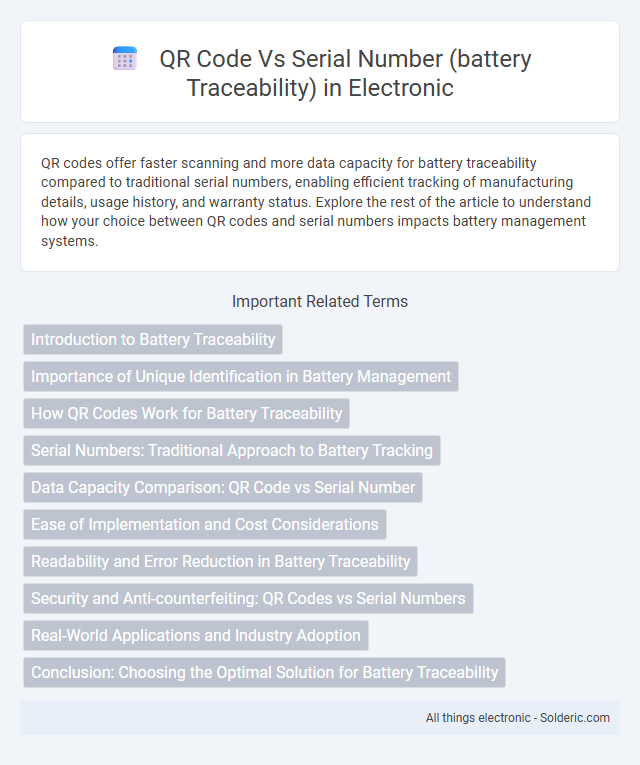QR codes offer faster scanning and more data capacity for battery traceability compared to traditional serial numbers, enabling efficient tracking of manufacturing details, usage history, and warranty status. Explore the rest of the article to understand how your choice between QR codes and serial numbers impacts battery management systems.
Comparison Table
| Feature | QR Code | Serial Number |
|---|---|---|
| Data Capacity | High - can store URLs, text, and product info | Low - typically numeric or alphanumeric code |
| Scan Speed | Fast - instant scanning via smartphone or scanner | Slower - manual entry often required |
| Traceability | Detailed - links to database with full battery history | Limited - requires cross-referencing serial number in system |
| Error Rate | Low - automated scanning reduces human errors | Higher - prone to manual input errors |
| Cost | Moderate - printing and code generation required | Low - simple number printing |
| Durability | Depends on label quality - can be waterproof and scratch-resistant | Permanent if engraved or printed clearly |
| Security | High - can encode encrypted or dynamic data | Low - easily copied or faked |
| Implementation Complexity | Higher - requires QR code generation and scanning infrastructure | Lower - simple numbering system |
Introduction to Battery Traceability
Battery traceability enhances safety, quality control, and regulatory compliance by tracking individual units from production to end-of-life. QR codes enable rapid scanning and detailed data retrieval, linking batteries to manufacturing records and usage history, while serial numbers provide a unique identifier for manual or digital logging. Implementing QR codes improves efficiency in battery traceability by offering dynamic and easily accessible information compared to traditional serial number tracking.
Importance of Unique Identification in Battery Management
Unique identification through QR codes or serial numbers is crucial in battery management to ensure accurate traceability and prevent counterfeit products. QR codes enable quick scanning and digital data access, enhancing your ability to monitor battery lifecycle, maintenance history, and warranty status efficiently. Serial numbers provide a straightforward, alphanumeric method for tracking individual batteries, supporting inventory control and quality assurance in manufacturing and distribution processes.
How QR Codes Work for Battery Traceability
QR codes store encoded data that can be quickly scanned and decoded using mobile devices or specialized readers, enabling instant access to battery information such as manufacturing date, batch number, and quality certifications. Unlike traditional serial numbers, which require manual entry and are prone to errors, QR codes streamline data retrieval, ensuring accurate and efficient traceability throughout the battery lifecycle. Your ability to scan QR codes accelerates inventory management, warranty claims, and safety recalls by providing precise, real-time battery history.
Serial Numbers: Traditional Approach to Battery Tracking
Serial numbers have long been the traditional method for battery traceability, providing a unique identifier for each unit that helps track manufacturing details, warranty status, and inventory management. This approach ensures precise batch-level monitoring but often requires manual entry, increasing the risk of human error and slower data retrieval. Incorporating serial numbers into your battery management system facilitates accountability and quality control, making it a foundational element in supply chain transparency.
Data Capacity Comparison: QR Code vs Serial Number
QR codes can store up to 7,089 numeric characters or 4,296 alphanumeric characters, significantly outperforming traditional serial numbers, which are typically limited to 10-20 characters. This high data capacity enables QR codes to embed detailed information such as manufacturing date, batch number, and warranty data, enhancing battery traceability. Serial numbers offer limited traceability due to their shorter length and lack of embedded metadata, making QR codes a superior choice for comprehensive battery tracking systems.
Ease of Implementation and Cost Considerations
QR codes offer ease of implementation with their quick digital generation and simple scanning using smartphones or handheld readers, significantly reducing manual effort. Serial numbers require consistent manual entry or specialized equipment for tracking, leading to higher labor costs and increased chances of human error. Your choice impacts overall cost efficiency, with QR codes typically providing lower implementation expenses and streamlined traceability in battery management systems.
Readability and Error Reduction in Battery Traceability
QR codes offer superior readability in battery traceability by enabling quick, accurate scanning that minimizes human input errors compared to serial numbers, which are prone to misreading and manual entry mistakes. The digital nature of QR codes facilitates automated data capture, significantly reducing error rates and improving traceability across the battery lifecycle. Enhanced error reduction ensures more reliable tracking for quality control, warranty management, and regulatory compliance in battery production and distribution.
Security and Anti-counterfeiting: QR Codes vs Serial Numbers
QR codes offer enhanced security and anti-counterfeiting advantages over traditional serial numbers due to their ability to store encrypted and complex data, making unauthorized duplication more difficult. Unlike serial numbers, QR codes can be dynamically linked to secure databases for real-time verification and traceability of battery origins and usage history. This integration reduces the risk of counterfeit products by enabling instant authenticity checks via smartphone scanning, thus strengthening supply chain integrity.
Real-World Applications and Industry Adoption
QR codes enable rapid scanning and data retrieval in battery traceability, widely adopted in automotive and consumer electronics industries for efficient inventory management and authenticity verification. Serial numbers remain crucial for detailed tracking and warranty claims, especially in aerospace and medical device sectors where precise historical data is essential. Many manufacturers integrate both methods to optimize supply chain transparency and enhance product lifecycle monitoring.
Conclusion: Choosing the Optimal Solution for Battery Traceability
QR codes offer rapid scanning, high data capacity, and enhanced error correction, making them ideal for detailed battery traceability. Serial numbers provide simplicity and ease of manual entry but lack the efficiency and data richness essential for comprehensive tracking. Selecting QR codes optimizes traceability by enabling quick identification, secure data integration, and improved supply chain transparency.
QR code vs serial number (battery traceability) Infographic

 solderic.com
solderic.com